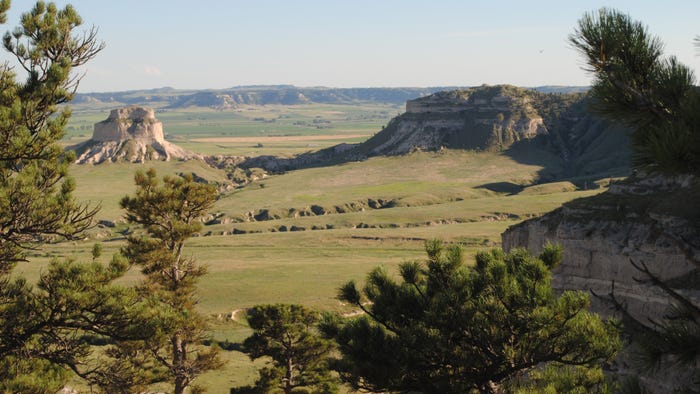
Photos by Curt Arens
Even for Nebraska residents who have never been away from the eastern urban centers or the Platte River Valley and Interstate 80, the southern Panhandle of the state may seem like another world. And among the most dramatic of the monuments in Nebraska’s “monument valley” is Scotts Bluff National Monument, just west of Gering and Scottsbluff.
Towering 800 feet above the North Platte River Valley and 4,659 feet above sea level, Scotts Bluff served as a landmark for native tribes and, later on, for overland emigrants on the Oregon, Mormon and California trails.
The well-known gap between Scotts Bluff and South Bluff nearby was originally called “Devil’s Gap,” and later renamed Mitchell Pass for nearby Fort Mitchell — as it became the primary route for westward emigrants, Pony Express riders, soldiers, missionaries and the telegraph. Modern day visitors to Scotts Bluff can walk through the pass on the Oregon Trail Pathway, a half-mile trail that follows a short section of the Oregon and California trails.
Native Americans were the first to camp on the slopes of what is now Scotts Bluff. A group of seven fur traders from the Robert Stuart Party were the first white men known to have seen Scotts Bluff on Christmas Day 1812.
In the summer of 1826, a trader caravan led by William Ashley, William Sublette, Jedediah Smith and perhaps, Hiram Scott, passed through the area. Later on, emigrant wagon trains passed this major landmark as they traveled in droves along the trails on their way to Oregon, California or Utah.
Along with a large visitor center, one of the best features of the national monument today is the 1.6-mile Summit Road, built in the 1930s, offering visitors a chance to reach the summit of Scotts Bluff by vehicle. The winding but scenic drive features the only three vehicle tunnels in the state.
There are also 4 miles of hiking trails, allowing guests to hike to the summit of the bluff and all around, offering spectacular views of the North Platte River Valley and the communities of Scottsbluff and Gering in the valley below.
Learn more at nps.gov.
About the Author(s)
You May Also Like






